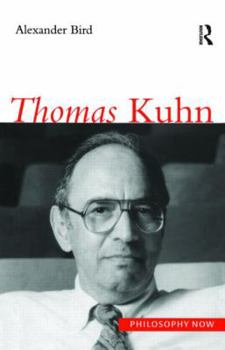Thomas Kuhn
Select Format
Select Condition 
Book Overview
Thomas Kuhn (1922-96) transformed the philosophy of science. His seminal 1962 work "The Structure of Scientific Revolutions" introduced the term 'paradigm shift' into the vernacular and remains a fundamental text in the study of the history and philosophy of science. This introduction to Kuhn's ideas covers the breadth of his philosophical work, situating "The Structure of Scientific Revolutions" within Kuhn's wider thought and drawing attention to...
Format:Paperback
Language:English
ISBN:1902683110
ISBN13:9781902683119
Release Date:January 2001
Publisher:Routledge
Length:320 Pages
Weight:0.82 lbs.
Dimensions:0.7" x 5.5" x 8.5"
Customer Reviews
1 rating
Somewhat out of touch
Published by Thriftbooks.com User , 16 years ago
Bird begins by claiming in the preface that Kuhn was not really a philosopher, and then devotes the rest of the book to amending Kuhn's wishy-washy layman's theories with the self-important rigour and precision of modern analytic philosophy. This approach is not without its merits but it also spirals inwards quite frequently and forgets that Kuhn's theories are about science after all. I will complain about some results of this lack of perspective. Bird claims that "some revolutions can be conservative accumulations of new but significant discoveries and theories. Such revolutions are not explicable in terms of one paradigm failing, generating a crisis and then being replaced by a competitor. These revolutions may just be blossoming of normal science. ... The case of the discovery of the structure of DNA illustrates this. ... [This] discovery that many regard as the most important of the century simply does not fit Kuhn's description of scientific development---it originated in no crisis and required little or no revision of existing paradigms even though it brought into existence major new fields of research." (pp. 60, 62). But Bird provides no evidence that this discovery was the result of normal science in Kuhn's sense. The fact that it "required little or no revision of existing paradigms" suggests on the contrary that it was the result of pre-paradigmatic research rather than normal science. That Bird fails to recognise this elementary distinction is ironic since he has just spent an entire chapter rambling about the difference between a "revolution_K" (meaning a revolution in Kuhn's sense) and a revolution in the common sense; if only he had taken the time to give "normal_K" science its own flashy subscript notation too then maybe he would not have confused it with "normal" science. In the chapter on "Perception and world change," Bird's main thesis is that "the effect of theoretical belief on perceptual experience is weak and marginal" (p. 122). On this basis he seems to draw the conclusion that Kuhn's claims regarding theory-ladenness of observation are relatively harmless (cf. pp. 147-148, 155, 202). But Bird's entire discussion concerns only direct sensory perception, while Kuhn also emphasised theory-ladenness of scientific data that is not directly perceptual ("The data themselves had changed"; Structure, p. 134). By completely ignoring this latter aspect of theory-ladenness Bird misrepresents Kuhn and omits an important factor from his later discussions of incommensurability and relativism. My final quarrel is with Bird's attempted refutation of incommensurability, in particular concerning Kuhn's claim that Newtonian mechanics is not a limiting case of Einsteinian mechanics since, e.g., Newtonian mass differs from Einstenian mass. The following is Bird's conclusion on the matter. "To summarize, Kuhn assumes that laws fix intensional meaning and thereby fix, in a strict manner, extension and reference. If it is further assumed th






